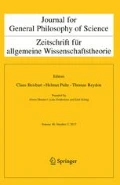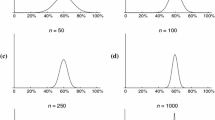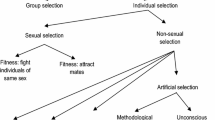Abstract
In this paper we present a new framework of idealization in biology. We characterize idealizations as a network of counterfactual and hypothetical conditionals that can exhibit different “degrees of contingency”. We use this idea to say that, in departing more or less from the actual world, idealizations can serve numerous epistemic, methodological or heuristic purposes within scientific research. We defend that, in part, this structure explains why idealizations, despite being deformations of reality, are so successful in scientific practice. For illustrative purposes, we provide an example from population genetics, the Wright-Fisher Model.


Similar content being viewed by others
Notes
The idea of considering idealizations as being statements goes back to Nowak (1980), although the idea already appears in Barr (1971), who speaks about idealized laws as “ideal cases” that are essentially understood as counterfactual statements with ideal conditions as their antecedents. In Barr’s approach, theories become classes of ideal cases (statements). As the statement view of scientific theories (for which theories are classes of statements) was abandoned by most philosophers of science in favor of the semantic view, idealizations were understood as the process of model construction or as the product of that process (see, for example, Suppe 1989 and Balzer et al. 1987). In the present article, we don’t want to favor any particular view about scientific theories. We just want to defend a certain account of idealization without committing us to any philosophically charged approach to scientific theories. Our proposal that idealizations are certain kind of statements is an idealization itself that is intended to help better understand their functioning in scientific reasoning.
As, for example, has been argued by Cleland and Copley (2005).
Compare this with Barr (1971, 261ff). These distinctions are very similar to Barr’s own terminology, although our analysis is different from his.
Authors such as Laymon (1982), Kuipers (1992a) and Kuipers (1992b) and Niiniluoto (1999) invoke the process of idealization-concretization in their different attempts to argue in favor of a convergent realism and method of approaching the truth. We do not want to commit ourselves to any form of scientific realism. The process of idealization-concretization may well serve to justify the use of idealizations, but not a substantive philosophical answer to the problem of scientific realism. See also Strevens’s (2008) take on this issue.
To keep things tidy, just remember that i = i t and j = i+1.
Also known as the mean of the binomial distribution.
References
Balzer, W., Moulines, C. U., & Sneed, J. D. (1987). An architectonic for science. Dordrecht: Reidel.
Barr, E. W. (1971). A syntactical and semantic analysis of idealization in science. Philosophy of Science, 38, 258–272.
Bechtel, W., & Richardson, R. C. (1993). Discovering complexity: Decomposition and localization as strategies in scientific research. Princeton: Princeton University Press.
Bennett, J. (2003). A philosophical guide to conditionals. Oxford: Oxford University Press.
Bennett, J., & Fine, K. (1975). Critical notice: Counterfactuals. Mind, 84, 451–458.
Cartwright, N. (1983). How the laws of physics lie. Oxford: Clarendon Press.
Cartwright, N. (1989). Nature’s capacities and their measurement. Oxford: Clarendon Press.
Cleland, C. E., & Copley, S. (2005). The possibility of alternative microbial life on earth. International Journal of Astrobiology, 4, 165–173.
Darden, L. (2002). Strategies for discovering mechanisms: Schema instantiation, modular subassembly, forward/backward chaining. Philosophy of Science, 69, S354–S365.
Darden, L., & Craver, C. (2002). Strategies in the interfield discovery of the mechanism of protein synthesis. Studies in History and Philosophy of Biological and Biomedical Sciences, 33C, 1–28.
Fisher, R. A. (1930). The genetical theory of natural selection. Oxford: Clarendon Press.
Fogelin, R. J. (1998). David Lewis on indicative and counterfactual conditionals. Analysis, 58(4), 286–289.
Gillespie, J. (2004). Population genetics: A concise guide. Baltimore, MD: Johns Hopkins University Press.
Godfrey-Smith, P. (2006a). Abstractions, idealizations, and evolutionary biology. Retrieved March 28, 2008 from Harvard University, Peter Godfey-Smith online papers: http://www.people.fas.harvard.edu/~pgs/OnlinePapers/PGSAbstractnIdealizn06.pdf.
Godfrey-Smith, P. (2006b). The strategy of model-based science. Biology and Philosophy, 21, 725–740.
Griesemer, J. R. (1990). Modelling in the museum. On the role of remnant models in the work of Joseph Grimell. Biology and Philosophy, 5, 3–36.
Helgason, A., Hrafnkelsson, B., Gulcher, J. R., Ward, R., & Stefánsson, K. (2003). A populationwide coalescent analysis of Icelandic matrilineal and patrilineal genealogies: evidence for a faster evolutionary rate of mtDNA lineages than Y chromosomes. American Journal of Human Genetics, 72(6), 1370–1388.
Jones, M. (2005). Idealization and Abstraction: A Framework. In M. Jones & N. Cartwright (Eds.), Idealization XII: Correcting the model (pp. 173–217). Amsterdam: Rodopi.
Jorde, P. E., & Ryman, N. (2007). Unbiased estimator for genetic drift and effective population size. Genetics, 177, 927–935.
Keller, E. F. (2000). Models of and models for: Theory and practice in contemporary biology. Philosophy of Science, 67(Proceedings), S72–S86.
Kimura, M. (1954). Process leading to quasi-fixation of genes in natural populations due to random fluctuation of selection intensities. Genetics, 39(3), 280–295.
Kingman, J. F. C. (1982). On the genealogy of large populations. In J. Gani & E. J. Hannan (Eds.), Essays in the statistical science (pp. 27–43). London: Applied Probability Trust.
Kingman, J. F. C. (2000). Origins of the coalescent: 1974–1982. Genetics, 156, 1461–1463.
Kitakado, T., Kitada, S., Obata, Y., & Kishino, H. (2006). Simultaneous estimation of mixing rates and genetic drift under successive sampling of genetic markers with application to the mud crab (Scylla paramamosain) in Japan. Genetics, 173, 2063–2072.
Krasner, D., & Heller, M. (1994). The miracle of counterfactuals: Counterexamples to Lewis’s world ordering. Philosophical Studies, 76(1), 27–43.
Kuipers, Th. (Ed.). (1987). What is closer-to-the-truth? A parade of approaches to truthlikeness. (Poznań studies in the philosophy of the sciences and the humanities, vol. 10). Amsterdam: Rodopi.
Kuipers, Th. (1992a). Naive and refined truth approximation. Synthese, 93, 299–341.
Kuipers, Th. (1992b). Truth approximation by concretization. In J. Brzezinski and L. Nowak (Eds.), Idealization III: approximation and truth. Poznań Studies in the Philosophy of the Sciences and the Humanities (Vol. 25, pp. 159–179). Amsterdam: Rodopi.
Kvart, I. (1992). Counterfactuals. Erkenntnis, 36(2), 139–179.
Labate, J. A., Biermann, C. H., & Eanes, W. F. (1999). Nucleotide variation at the runt locus in Drosophila melanogaster and Drosophila simulans. Molecular Biological Evolution, 16(6), 724–731.
Laymon, R. (1982). Scientific realism and the hierarchical counterfactual path from data to theory. In P. Asquith and T. Nickles (Eds.), PSA 1982 (Vol. 1, pp. 107–121). Michigan: East Lansing.
Laymon, R. (1985). Idealizations and the Testing of Theories by Experimentation. In P. Achinstein & O. Hannaway (Eds.), Experiment and observation in modern science (147–173). Boston: MIT Press and Bradford Books.
Levins, R. (1966). The strategy of model building in population biology. American Scientist, 54, 421–431.
Lewis, D. (1973). Counterfactuals. Oxford: Blackwell.
Machamer, P., Darden, L., & Craver, C. F. (2000). Thinking about mechanisms. Philosophy of Science, 67, 1–25.
McMullin, E. (1985). Galilean idealization. Studies in the History and Philosophy of Science, 16, 247–273.
Mitchell, S. (2000). Dimensions of scientific law. Philosophy of Science, 67, 242–265.
Nagylaki, T. (1979). The island model with stochastic migration. Genetics, 91(1), 163–176.
Niiniluoto, I. (1987). Truthlikeness. Dordrecht: Reidel.
Niiniluoto, I. (1998). Verisimilitude: The third period. British Journal for the Philosophy of Science, 49, 1–29.
Niiniluoto, I. (1999). Critical scientific realism. Oxford: Oxford University Press.
Nowak, L. (1980). The structure of idealization. Dordrecht: Reidel.
Nowak, L. (2000). Darwin’s theory of the natural selection. In L. Nowak and I. Nowakowa: Idealization X: The richness of idealization (pp. 63–94). Amsterdam: Rodopi.
Nowak, L., & Nowakowa, I. (2000). Idealization X: The richness of idealization. Amsterdam: Rodopi.
Nozick, R. (2001). Invariances :The structure of the objective world. Cambridge: Harvard University Press.
Nute, D. (1976). David Lewis and the analysis of counterfactuals. Noûs, 10(3), 355–361.
Pruss, A. R. (2007). Conjunctions, Disjunctions and Lewisian Semantics for Counterfactuals. Synthese, 156(1), 33–52.
Schlossberger, E. (1978). Similarity and counterfactuals. Analysis, 38(2), 80–82.
Shapere, D. (1969). Notes towards a post-positivistic interpretation of science. In P. Achinstein and S. Barker (Eds.), The legacy of logical positivism (pp. 115–160), Baltimore: John Hopkins University Press.
Skalski, G. T. (2007). Joint estimation of migration rate and effective population size using the island model. Genetics, 177, 1043–1057.
Strevens, M. (2008). Depth: an account of scientific explanation. Cambridge: Harvard University Press.
Suppe, F. (1989). The semantic conception of theories and scientific realism. Urbana and Chicago: University of Illinois Press.
Tooley, M. (2003). The Stalnaker-Lewis approach to counterfactuals. The Journal of Philosophy, 100(7), 371–377.
Walsh, D. M., Lewens, T., & Ariew, A. (2002). The trials of life: natural selection and random drift. Philosophy of Science, 69, 452–473.
Waples, R. S., & Yokota, M. (2007). Temporal estimates of effective population size in species with overlapping generations. Genetics, 175, 219–233.
Weisberg, M. (2006a). Forty years of ‘The Strategy’: Levin’s on Model Building and Idealization. Biology and Philosophy, 21, 623–645.
Weisberg, M. (ed.) (2006b). Richard Levins’ Philosophy of Science, Biology & Philosophy, 21 (5).
Weisberg, M. (2007). Three kinds of idealization. Journal of Philosophy, CIV(12), 639–659.
Wimsatt, W. C. (1987). False models as means to truer theories. In M. H. Nitecki & A. Hoffman (Eds.), Neutral models in biology (pp. 23–55). New York: Oxford University Press.
Wimsatt, W. C. (2002). Using false models to elaborate constraints on processes: blending inheritance in organic and cultural evolution. Philosophy of Science, 69, S12–S24.
Wright, S. (1931). Evolution in Mendelian populations. Genetics, 16, 97–159.
Acknowledgments
This paper has received financial support from the Spanish Ministry of Science and Innovation (Research Project Ref.: FFI2009-08828/FISO). A postdoctoral fellowship was awarded to Alfonso Arroyo Santos by the CONACyT (“Programa de Estancias posdoctorales vinculadas al fortalecimiento de la calidad del posgrado nacional” 2010). Previous versions of this article were presented at different conferences, including the PSA Biennial Meeting held on November 6–8, 2008 in Pittsburgh. The authors would like to thank the audiences on those occasions, and specially Mark E. Olson and two anonymous referees of this journal for their helpful comments.
Author information
Authors and Affiliations
Corresponding authors
Rights and permissions
About this article
Cite this article
de Donato Rodríguez, X., Arroyo Santos, A. The Structure of Idealization in Biological Theories: The Case of the Wright-Fisher Model. J Gen Philos Sci 43, 11–27 (2012). https://doi.org/10.1007/s10838-012-9185-1
Published:
Issue Date:
DOI: https://doi.org/10.1007/s10838-012-9185-1




